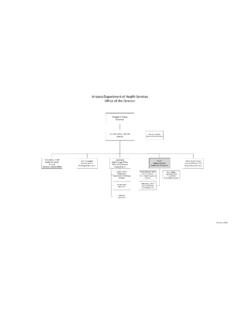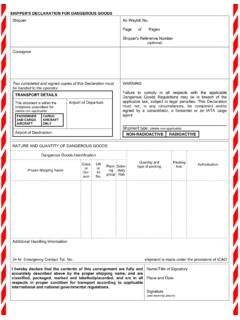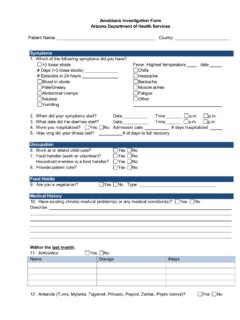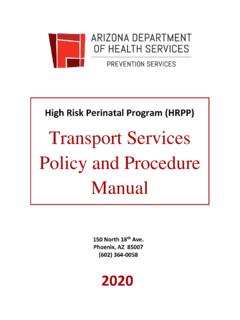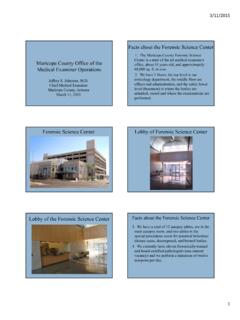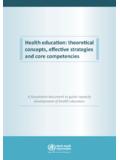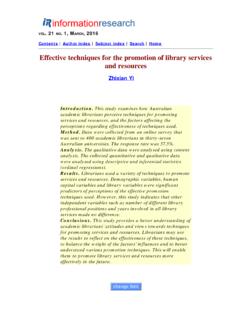Transcription of What is Evidence-based Health Promotion?
1 1 What is Evidence-based Health Promotion? Mary Altpeter, PhDUNC Institute On AgingSeptember 28, 20072 Thanks {Mary Altpeter, Ellen Schneider, UNC Institute on Aging{Mary Warren, Triangle J AAA{Becky Hunter, Carolina Geriatric Education Center, UNC{Audrey Edmisten, NC DAASAnd to our committee of NC AAA Barker, Region A; Gayla Woody, Region F; Dean Burgess, Region I; Joan Pelletier, Region J; Carolyn Tracy, Region M; Jane Jones, Region O; Cynthia Davis, Region Health promotion , evidence, Evidence-based Health the perceived advantages and disadvantages in Evidence-based Health promotion the anatomy of an Evidence-based Health promotion program{illustration Chronic Disease Self-Management Program (CDSMP){illustration -A Matter of Balance/Lay Leader Model about resources for finding and implementing Evidence-based Health promotion programs4 Definitions: What is Health promotion ?}}}}}}
2 {Process of planning, implementing, and evaluating:zprograms that help individuals gain skills and adopt beneficial Health behaviors zprograms and policies at the community level that improve living conditions (physical environments) and encourage healthy, safe lifestyles{Approaches (programs) that improve individual-level lifestyles and community level living conditions5 Definitions: What is Evidence?{Evidence of a Health issuezSomething should be done{Evidence that a program is effective in addressing the Health issuezThis should be done{Evidence about the design, context, and attractiveness of program to participants and otherszThis is how it should be done6 Sources of Evidence{Data from intervention research studies { Translational projects that take proven interventions and adapt them in real world settings{Data from our programs7 What is Evidence-based Health promotion ?}}}}}}}}
3 A process of planning, implementing, and evaluating programs adapted from tested models or interventions in order to address Health issues at an individual level and at a community level85 Crosscutting Tasks/Strategies of Evidence-based Health promotion level zUsing effective self-management approacheszEmploying assessment, goal setting, action planning, problem solving, follow-up and familial contextzUsing peer support, peer Health mentors, professional support, role modeling, sharing and feedback, reinforcementAdapted from Nancy Whitelaw presentation, AHRQ Conference, 200695 Crosscutting Tasks/Strategies of Evidence-based Health promotion Programs (continued) contextzFocusing on the saliency, appeal and adaptation to community norms, language, customs, to Health carezBuilding partnerships with public Health , Health care providers, hospitals, Health care systemsAdapted from Nancy Whitelaw presentation, AHRQ Conference, 2006105 Crosscutting Tasks/Strategies of Evidence-based Health promotion Programs (continued) focuszTracking social, mental, physical and functional changeszUsing objective and self-reported subjective measures11 Perceived Disadvantages of Evidence-based Approach{Requires knowing where to find and how to understand/judge the evidence {Feels like standardization of programs rather than site-specific tailoring{Tools and processes are unfamiliar{Difficult to build community support many prefer home grown to off the shelf {Can be expensiveAdapted from.}}}}}
4 Nancy Whitelaw, Director, NCOA Center on Healthy Aging12 Perceived Advantages of Evidence-based Health promotion {Increases the likelihood of positive outcomes{Leads to efficient use of resources{Facilitates the spread of programs{Facilitates the use of common performance measures{Supports continuous quality improvement{Makes it easier to justify funding{Helps to establish partnerships esp. with Health care13 Anatomy of an Evidence-based a specific target specific, measurable goal(s) a stated reasoning behind it and proven a well-defined program structure and timeframe so others understand how the program staffing facility and equipment in program evaluation to measure program quality and Health outcomes14 Anatomy of an Evidence-based Program Using Chronic Disease Self Management Program (CDSMP)as an target populationzDesigned to address chronic diseases such as asthma, bronchitis, emphysema, heart disease, diabetes and arthritis among adultszParticipants must be willing/able to attend group meetings, complete action plans15 Anatomy of an Evidence-based Program Using CDSMPas an example2.}}}}}}}
5 Has specific, measurable goal(s){Increase knowledge about chronic disease{Increase function and comfort through changes in Health behaviors and coping strategies{Change role of the patient from passive care recipient to active self-management{Foster effective patient communication with physician16 Anatomy of an Evidence-based Program Using CDSMPas an example3. Has stated reasoning behind itand proven benefits{Self-cognitive theory that systematically uses strategies to enhance self-efficacyzWeekly action planning and feedbackzModeling of behaviors zReinterpretation of symptomszGroup problem-solving zSkills masteryzSocial persuasion and sharingzIndividual decision-making17 Anatomy of an Evidence-based Program Using CDSMPas an stated reasoning behind it and proven benefits{Proven benefits: Weekly minutes of exercise Frequency of cognitive symptom management Communication with physicians Self-reported Health Health distress Fatigue Disability Social/role activities limitations HospitalizationsLorig, K.}}}}}}
6 Et al. (1999). Evidence Suggesting that a Chronic Disease Self-Management Program Can Improve Health Status While Reducing Hospitalization: A Randomized Trial. Medical Care, 37(1) pp. of an Evidence-based Program Using CDSMPas an example4. Has a well-defined program structure and timeframezSmall peer-led groups of 10-16 peoplez6 weekly sessions zSessions last hourszHighly structured teaching protocol/script covering: {Understanding chronic disease, becoming an active self-manager, finding resources, understanding and managing symptoms, exercise, communications, sex and intimacy, healthy eating, managing medications, planning for the futurezStandardized participant materials (book)19 Anatomy of an Evidence-based Program Using CDSMPas an example5. Specifies staffing needs/skill{Standardized 20-hour training for leaders6. Specifies facility and equipment needszPhysical facility must have sufficient space for comfortable and private effective group interactionzClutter free, no drafts, adequate lightingzAccessible and familiar facility20 Anatomy of an Evidence-based Program Using CDSMPas an example7.}}
7 Builds in program evaluation to measure program quality and Health outcomesProgram Quality:zMonitoring of instructors to ensure program is implemented according to protocols and scriptzSatisfaction survey (of program, instructor)21 Anatomy of an Evidence-based Program Using CDSMPas an example7. Builds in program evaluation to measure program quality and Health outcomeszHealth Outcomes{ Health behaviors(minutes of exercise, social/role limitations, cognitive symptom management, self-efficacy){ Health status( , self-rated Health , scales for pain and discomfort, energy fatigue, Health distress){ Health service utilization(medical visits, hospitalizations)22 Other Versions of CDSMP{CDSMP Spanish version{Arthritis self-management (English, Spanish){Tomando Control de Su Salud{Tomando Control de Su Diabetes{Positive Self-Management (HIV/Aids){Internet Self-Management (arthritis, CDSMP)Source.}}}}}}}}}
8 Adapted from Kate Lorig presentation, AHRQ conference, 20062323 Anatomy of an Evidence-based Program Using A Matter of Balance/Lay Leader Modelas an target populationz60 or older, ambulatory, able to problem-solvezConcerned about fallszInterested in improving flexibility, balance, and strength24242. Has specific, measurable goal(s)zReduce fear of falling zStop the fear of falling cyclezIncrease activity levels among community-dwelling older adults Anatomy of an Evidence-based Program Using A Matter of Balance/Lay Leader Modelas an stated reasoning behind itand proven benefits{MOB acknowledges the risk of falling BUT emphasizes practical coping strategies.{Self-cognitive theory that systematically uses strategies to enhance self-efficacy{Group format provides an opportunity to learn from each other and to help each other deal with the shared problem of fear of of an Evidence-based Program Using A Matter of Balance/Lay Leader Modelas an example26 Anatomy of an Evidence-based Program Using A Matter of Balance/Lay Leader Modelas an example3.}}}
9 Has stated reasoning behind it and proven benefits Falls (prevention) Efficacy Falls Management Falls Control Exercise level Decrease in Monthly Falls 26 Healy, T., Peng, C., Haynes, M., McMahon, E., Botler, J., & Gross, L. (in press). The feasibility and effectiveness of translating A Matter of Balanceinto a volunteer lay leader model. Journal of Applied Has a well-defined program structure and timeframezEight two-hour classesz10-12 participants (minimum of 8, maximum of 14)zProgram structure includes:{Group discussion{Problem-solving{Skill building{Assertiveness training{Exercise training{Sharing practical solutions{Cognitive restructuringzStandardized participant materials (book)Anatomy of an Evidence-based Program Using A Matter of Balance/Lay Leader Modelas an example28285. Specifies staffing needs/skillzEight hours of coach training; coach must facilitate two classes within one year to complete certificationzCoach Skills:{Good communication and interpersonal skills{Enthusiasm, dependability{Willingness to lead a small group{Interest in working with older adults{Life experiences valued, with education or Health care experience a plus.}}}}}}}}}}}}
10 {Ability to perform range of motion and low-level endurance exercises{Ability to carry up to 20 of an Evidence-based Program Using A Matter of Balance/Lay Leader Modelas an example29 Anatomy of an Evidence-based Program Using A Matter of Balance/Lay Leader Modelas an example6. Specifies facility and equipment needszEnough space for each participant to move around comfortablyzTables, preferably set up in a U-shapezChairszADA accessiblezSpace to set up snacks2930307. Builds in program evaluation to measure program qualityand Health outcomesProgram Quality:zMonitoring of instructors to ensure program is implemented according to protocols and scriptzExperienced coaches are paired with new coachesAnatomy of an Evidence-based Program Using A Matter of Balance/Lay Leader Modelas an example31317. Builds in program evaluation to measure program quality and Health outcomesHealth Outcomes:zInitial survey given (falls management, exercise levels, and background information)zLast class survey.}}
